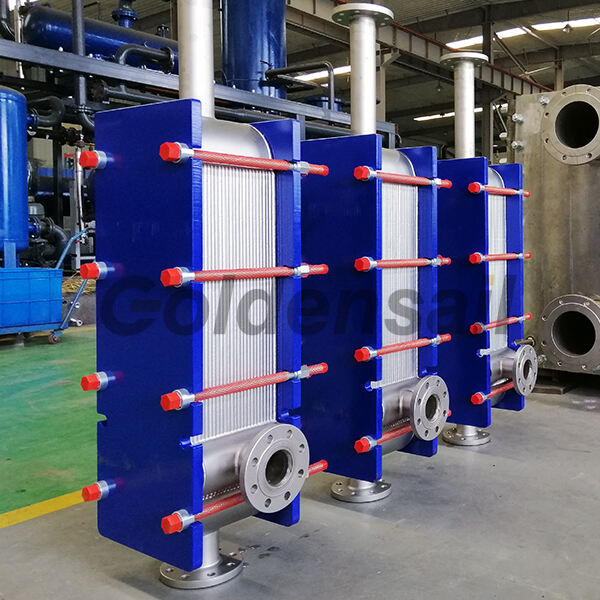Looking for a Fully welded plate and frame heat exchanger? Then JINFAN is just right.
We are a first-class full welded plate heat exchanger manufacturer & supplier. The fully welded plate and frame heat exchanger is a new concept in heat transfer technology. It combines the advantages of both gasket and frame plate heat exchangers and shell and tube heat exchangers.
The fully welded plate heat exchanger achieves efficient heat exchange between two fluids through the welding structure between metal plates. It combines the high heat transfer efficiency of the plate heat exchanger with the high-strength sealing performance of the shell and tube heat exchanger, and is particularly suitable for heat exchange conditions of high temperature, high pressure or corrosive fluids.
The plates are made of fishbone corrugation, diamond corrugation or special customized patterns to increase the turbulence and heat transfer coefficient of the fluid. Adjacent plates are welded in pairs to form a closed channel, and the hot fluid and the cold fluid enter the heat exchanger from the inlet and outlet on both sides, respectively, and enter their independent plate channels. Laser welding or TIG (argon arc) welding is commonly used to achieve high sealing. The welds are located at the edges and contact points of the plates, and no rubber gaskets are required. All plates are welded or clamped in a rigid shell to ensure structural strength and adapt to the interface pipes. The equipment is equipped with inlet and outlet ports for easy connection to the user system.

✅ Compact and space-saving design. WPHE occupies less floor space compared to traditional shell and tube heat exchangers.
✅ Provide efficient heat transfer due to its large surface area and turbulent flow created by the pattern of welded plates. This results in improved thermal performance and reduced energy consumption.
✅ Constructed using corrosion-resistant materials such as stainless steel or titanium. This makes it ideal for handling corrosive fluids and environments, ensuring long-term durability and reliability.
✅ Understand high temperatures and pressures, making it suitable for applications that require heat transfer in extreme operating conditions.
✅ Designed for easy maintenance and cleaning. The plates can be easily accessed and cleaned, reducing downtime and ensuring optimal performance.
✅ Advanced laser welding technology is suitable for high temperature, high pressure or corrosive media, avoiding gasket aging problems.
✅ The welded sealing structure greatly reduces the risk of leakage and is suitable for the heat transfer of corrosive fluids.
✅ The corrugated plate design optimizes the heat exchange area and turbulence effect, and the heat exchange efficiency is much higher than the shell and tube type.
✅ No need to frequently replace gaskets, eliminating the trouble of disassembly and assembly, and long-term operation is more reliable.
✅ Provide 316L, titanium, hastelloy, etc. to meet a variety of corrosion conditions.
| Category | Fully Welded Plate Heat Exchanger | Shell-and-Tube Heat Exchanger |
|---|---|---|
| Heat Transfer Efficiency |
★★★★☆ High Thin plates + turbulence-enhancing design |
★★☆☆☆ Medium-Low Large surface area but lower transfer efficiency |
| Footprint | Compact, space-saving | Bulky, requires large installation space |
| Pressure Resistance | High (up to 4.5 MPa) | Very High (up to 10 MPa or more) |
| Temperature Resistance | Up to 350°C | Up to 500°C |
| Channel Design | Multiple channels, uniform flow distribution | Simple structure, risk of uneven flow |
| Cleanability | Non-detachable (CIP cleaning required) | Detachable (Manual cleaning allowed) |
| Maintenance Cost | Low: no gaskets, minimal maintenance | High: frequent disassembly and inspections needed |
| Application Conditions | High temperature/pressure, toxic or corrosive fluids | General high-temperature or clean fluids |
| Sealing Performance | Excellent: fully welded, no leakage | Moderate: flanges and gaskets require attention |
| Installation Flexibility | Vertical or horizontal installation supported | Typically horizontal; space-consuming |
| Initial Investment | Medium to high (but saves long-term costs) | Medium (but higher lifetime maintenance cost) |
| Typical Applications | Petrochemical, metallurgy, desalination, power | Power plants, turbines, oil cooling, steam condensers |
✅ Recommendation: For high-efficiency, high-safety, and corrosive conditions, we strongly recommend the Fully Welded Plate Heat Exchanger.
✅ The fully welded plate heat exchanger is commonly used in the chemical industry for applications such as heating or cooling corrosive fluids, condensing or evaporating solvents, and recovering heat from chemical processes. Its corrosion-resistant materials and compact design make it suitable for handling aggressive chemicals.
✅ In the oil and gas industry, the fully welded plate heat exchanger is utilized for applications such as oil cooling, gas processing, and heat recovery from refinery processes. Its high thermal efficiency, compact size, and ability to handle high temperatures and pressures make it ideal for these demanding conditions.
✅ The welded plate and frame heat exchangers are employed in power plants for various heat transfer tasks. They are used for cooling turbine oil, condensing steam, and heating or cooling feedwater. Their compact design and high heat transfer efficiency contribute to improved energy efficiency and reduced operating costs.
✅ The fully welded plate heat exchanger finds applications in the food and beverage industry for processes such as pasteurization, sterilization, and cooling of food and beverage products. Its hygienic design, easy cleaning, and high heat transfer efficiency ensure product safety and quality.
✅ Fully welded plate heat exchangers are used in heating, ventilation, and air conditioning (HVAC) systems for heat transfer between hot and cold water streams. Their compact size, high thermal efficiency, and ability to handle varying load conditions make them suitable for HVAC applications.